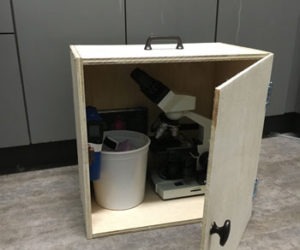Keep Your Mash Tun Insulated
I entered all-grain homebrewing the way many of us do: I found the simplest and most affordable method that worked. For me, this was a combination of a large pot on the stove and a grain bag for easy infusion mashing and batch sparging. Using a single pot for the mash and the boil reduces your initial equipment costs and removes the need to transfer liquids between vessels, but keeping your mash temperature constant in a bare metal pot can be a challenge. This is especially true when you’re brewing small batches, because you don’t have the thermal mass of a large volume of water.
My solution was to make this “tun cozy,” an insulating jacket for my brew pot, which I can easily remove when it’s time to start the boil. I now lose less than 4 °F (2 °C) per hour when mashing. It’s perfect for single-vessel brew-in-a-bag setups like mine. It can even be used for a standalone mash tun or hot liquor tank.
The design uses canned expanding foam, handy for filling large gaps in all sorts of do-it-yourself jobs around the home. This stuff has excellent thermal insulation properties. Even better is that it’s readily available, easy to use, and inexpensive. This whole project cost me around $25.
In a nutshell, you’re going to wrap your brew pot in aluminum foil, stand it on a spacer within a larger container, and then fill in the gap with expanding foam. When the foam sets you’ll have a tailor-made, removable insulating jacket for your pot.
I’ve made two of these so far. The first was for a rather modest 4-gallon (15-L) pot, which is great for small batches of around 2.5 gallons (9.5 L). More recently I built an 8.5-gallon (32-L) version, which is ideal for 5-gallon (19-L) batches. The great thing about this design is that it works for almost any vessel, providing you can find the right size container to stand it in. This article will guide you through building my 8.5-gallon (32-L) tun cozy, but keep in mind that you can use the same steps to build a tun cozy of any size to fit your needs.
The main challenge will probably be locating a suitable container. I found that a large rubble bucket (Gorilla Tub is a popular brand name) was ideal for my 8.5-gallon (32-L) pot. The foam doesn’t stick well to this type of plastic either, so the bucket can be used again after the project is finished. You’re looking for something between 3–6 inches (7.5–15 cm) larger than your pot on every side (including underneath). The smaller the space, the less expanding foam you will need, but also less insulation it will provide. In total, this project will take a couple of days from start to finish, however most of that time is spent allowing the foam to harden.
Note: Wear gloves and appropriate (old) clothing, because this expandable foam is very difficult to remove once it has set.
PARTS & TOOLS
Brew pot
Large container
2–3 cans of expanding foam
A plywood off-cut and three
3–4 inch (7.5–10 cm) nylon bolts with nuts
Aluminum foil
Non-serrated blade (a chef’s knife works well)
Tape


